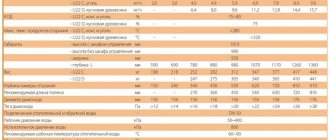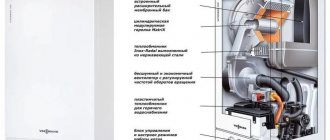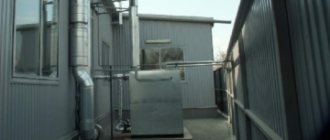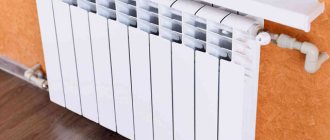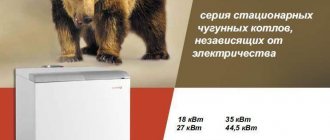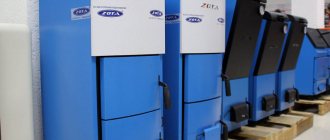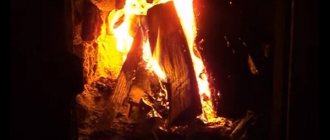When deciding on the organization of heat supply, the correct choice of equipment occupies a central place. The heat generator is the center of any heating system, and the productivity of the entire heating circuit as a whole depends on the efficiency of its operation. The heating equipment market offers a lot of different solutions.
Solid fuel boilers still remain in demand and popular, largely due to the possibility of modification. Installing heating elements (tubular electric heaters) is a fairly simple and relatively cheap way to transform a solid fuel boiler into a combined device that produces heat using electricity. A solid fuel boiler with heating elements is essentially a unit in which there is the possibility of alternative or joint use of the main types of fuel and electricity.
Connecting a heating element in a heating system paired with a solid fuel boiler.
Installation of heating elements in the boiler.
As a rule, most manufacturers of solid fuel boilers provide for the insertion of electric heating elements, and often they are already supplied as a kit. The most common options are heating elements with a power of 6 kW (3 heating elements of 2 kW each) and 9 kW (3 heating elements of 3 kW each).
The boiler has a 1” threaded hole on the opposite side of the return in the lower part. The heating element is installed through a rubber sealing ring. Tightening is done with an adjustable wrench (be careful not to damage the terminals on the ceramic bushings)
Connection diagram for the heating element on the boiler:
Normal switching via AT is performed as follows: Parallel one end from each heating element by installing a jumper - this will be a common zero with its own machine. We supply phases to the remaining three outputs via AT. According to this connection diagram, each heating element can be powered separately at 220 volts. But even without zero, you can apply 380 Volts in series to two heating elements, obtaining a greater range in power selection.
Connecting the heating element via an automatic control unit:
An excellent option for automatically maintaining the operating temperature in the boiler. This is precisely why the heaters are provided in the boiler, to maintain the temperature at night or during the inspection process. Having a thermostat, the heaters are controlled by turning on from a set lower temperature and turning off at a set upper value. The heating elements are connected to the block, the temperature sensor is installed at the outlet of the boiler.
When deciding on the organization of heat supply, the correct choice of equipment occupies a central place. The heat generator is the center of any heating system, and the productivity of the entire heating circuit as a whole depends on the efficiency of its operation. The heating equipment market offers a lot of different solutions.
Solid fuel boilers still remain in demand and popular, largely due to the possibility of modification. Installing heating elements (tubular electric heaters) is a fairly simple and relatively cheap way to transform a solid fuel boiler into a combined device that produces heat using electricity. A solid fuel boiler with heating elements is essentially a unit in which there is the possibility of alternative or joint use of the main types of fuel and electricity.
On practice
If you buy a ready-made boiler and do not assemble it yourself, then you will have a boiler control unit that will have terminals for connecting the power supply.
The only thing you need to do is to correctly calculate the cross-section of the power cable and the rating of the circuit breaker for the boiler.
I wrote about this in the articles How to select a cable in an electrical network and Calculation of cable cross-sections and circuit breakers.
Let me briefly remind you that these calculations are carried out based on the boiler power using tables 1.3 of the PUE. Since aluminum will soon be returned to electrical installations, I will provide summary tables from which you can select the cable cross-section according to the power of the device for copper and aluminum wires (cable cores).
This table for selecting cable cross-sections and protection devices for Protherm Skat boilers will also help.
Radiator electric heating at home
Installation diagram of the heating element in the radiator
Before installing a heating element into the heating system, you need radiator parameters. The main one is the diameter of the connecting pipe. Currently, manufacturers produce products in two sizes - 1/2 and 3/4 inches. Then a comparative analysis of the heating parameters is carried out before and after installing the heating element.
Connecting the heating element to the existing heating
If it will be used as an additional method of heating water, you need to take into account the change in hydraulic pressure when passing through the radiator. Since the flow diameter of the system this month will be smaller, it is recommended to install a pump of higher power.
When connecting a radiator to the system, installing a heating element for heating the house will not be possible. To do this, you must either change the connection diagram to the top, or install a heating element on the top of the battery, which is not recommended by experts.
They are often installed in old cast iron batteries. Before performing work, you must first check the direction of the thread of the pipe (right or left) and also measure its diameter. Then you should follow this scheme:
- Coolant drain. It is prohibited to install a heating element into a heating radiator if there is water in it;
- Checking the battery level. Even at a slight angle of inclination, the likelihood of air pockets significantly increases;
- Installing the heating element into the pipe. To seal the holes, you must use the gaskets supplied with the heating element or make them yourself;
- Installation of a unit with a thermostat, if included.
An example of installing a heating element in a cast iron radiator
After this, you need to fill the system with water. Using the installed Mayevsky crane, possible air pockets are removed. Before switching on, to ensure safety, a tester is used to check any possible heating coil-battery circuit. If there is one, you need to dismantle the heating element and install it again, improving the sealing.
Radiator electric heating
When organizing heating using heating elements made by yourself, installation of a pipeline is not necessary. A heating element must be installed on each radiator. At the same time, it is possible to install models of different power depending on the thermal conditions in a specific room of the house. The advantages of such a system are as follows:
- Saving on the purchase of materials and reducing the labor intensity of installation work;
- If you use a heating element with a thermostat for heating and a temperature sensor connected to it, the degree of heating of the room will be adjusted automatically;
- Minimum system heating inertia.
But all these positive qualities can be offset by the total cost of service. Therefore, before heating with electric heaters, you need to calculate not only the cost of purchasing materials and components, but also the subsequent costs of electricity. Only after this should a heating system of this type be introduced.
It is recommended to purchase factory radiators with installed heating elements. Their operating efficiency is higher than that of homemade ones, since special oil is used as a coolant. Even when the heating element is turned off, it will give off heat to the room for some time.
Prevention of breakdowns of heating elements
Needle heating element without the ability to adjust power
Even after you have managed to professionally install the heating element of heating systems, you must follow the operating rules. First, the ability of the electrical network to withstand maximum loads is checked. To do this, you need to sum up all the power of electrical appliances in the house and add a factor of 1.2 to the resulting figure for the power reserve. The cross-section of the electrical wiring must withstand the rated power without overheating or short circuiting.
The operation of the heating elements in the device consists in the gradual destruction of the heating spiral. Therefore, heaters intended for radiators must have a maximum service life of at least 10 years, which is confirmed by the manufacturer. In addition, you must follow these rules:
- Do not add tap water to pipes or heating radiators. This can lead to scale formation on the surface of the heating element. Use only distilled water;
- Installation of an RCD (residual current device) is required. You can connect one or more heating elements to it. When an emergency occurs, this device will cut off the power supply;
- Frequently turning the heater on and off when heating a house reduces its service life;
- If static electricity is observed on the surface of the battery, you urgently need to check the tightness of the heating element;
- Installing a heating element into a heating boiler or radiator without grounding is prohibited.
Guided by these simple recommendations, you can create not only an effective, but also a safe heating system for a private house or apartment using electric heating devices.
You cannot install a heater in a heating system without first checking the grounding. To do this, it is best to use the services of an electrical laboratory.
Additional functions of electric heaters
Above we discussed the simplest designs of devices that do not have any built-in adjustment mechanisms.
But electric water heaters can be equipped with simple automation that provides the device with additional functions.
These include:
- Thermoregulation. Heating elements with a built-in thermostat for heating have a temperature sensor that is triggered when the working environment is heated to a certain level. The electric heater is adjusted from the outside of the flange.
- Antifreeze. This function is provided by a simplified thermostat, which operates only when the temperature drops to 0-2°C. It prevents water from freezing in heating pipes, consuming a minimum of electricity.
- Turbo heating, which provides forced heating of the working environment during the initial start-up of equipment. It must be remembered that the electrical wiring of the room must withstand a short-term increase in power.
There are not many devices that support additional functions, because the operation of heating devices as a whole is often regulated using a separate automation unit.
Types and methods of manufacturing heating elements
Modern electric heating elements have high strength and the ability to change shape and size under the influence of high temperatures without compromising their technical characteristics. They are used not only in household heating appliances, but also in industrial ones. True, in the latter they install more powerful analogues with larger sizes. All modern heating elements have a high rate of long-term operation.
Manufacturers produce two types of heating elements, which differ in the manufacturing method. There are products that are mass produced, and there are also those that are produced in small batches. They usually meet specific customer requests. They are used in special heating installations with specific requirements. By the way, the price of the latter is much higher than the former.
Tubular electric heaters
This is the most common type of heating element, which is used in almost all electrically powered heating devices. With the help of tubular analogues, heating of the coolant occurs according to the principles of convection, radiation and thermal conductivity as a result of the conversion of electrical energy into thermal energy.
This heating element has the following characteristics:
- Tube diameter 6.0-18.5 millimeters.
- The length of the heating element is 20-600 centimeters.
- The tube can be made of steel, stainless steel or titanium (a very expensive device).
- Device configuration - no restrictions.
- Parameters (power, performance, etc.) - as agreed with the customer.
Finned tubular electric heaters
Used to heat air or gas that heats the room
TEHPs are the same tubular electric heater only with ribs that are located in planes perpendicular to the axis of the heating tube. Typically, the fins are made of metal strip and secured to the tube with special clamping nuts and washers. The heating element itself is made of either stainless steel or structural steel.
This type of electric heating devices is used to heat air or gas that heats a room. They are often used in heating devices such as air curtains and convectors - where heating with heated air is required.
Electric heater block
TENB are used only if it is necessary to increase the power of the electric heater. They are usually installed in devices in which the coolant is liquid or any bulk material.
A distinctive design feature of the heating element is its fastening to the heating device. It can be threaded or flanged. Particularly popular today is a block-type heating element with collapsible flanges. Such a heating element can be used repeatedly for different devices. The burnt heating element can be removed and a new one put in its place.
Cartridge-type electric heaters
This type is not used for heating systems.
This type is not used for heating systems. It is used as a mold part to create any products, since it is a part of industrial equipment. They are not found in everyday life, but it is necessary to mention them, because this type of heating element is included in the category “tubular electric heaters”.
A distinctive feature of this analogue is the shell, made of stainless steel, which is polished to the maximum. This is necessary so that the heating element can enter the mold with a minimum gap between the tube and the walls of the mold. The standard gap should not exceed 0.02 millimeters. This is how tightly it should fit.
Ring electric heaters
This type of heating elements is also used only in industrial installations. Their purpose is to heat injectors, nozzles of injection units and injection molding equipment.
The minimum twisting diameter is 8 millimeters, the maximum is not limited. The tube can be wound with the same or variable pitch. Typically this type is made only from stainless steel.
Electric heaters with thermostat
Heating element with thermostat TECHNO 2 kW
This is the most common heating element today, which is used to heat liquids. It is installed in all household electrical appliances that are associated with heating water. The maximum temperature of the released heat is +80C.
It is made from nickel-chromium wire, which is filled inside the tube with a special compressed powder. The powder is magnesium oxide, which is a good insulator of electric current, but at the same time has a high thermal conductivity.
Heating element and single-phase network. What to screw to what?
This case is typical for dachas and old-built village houses. First you need to generally understand what we are talking about and the easiest way to do this is by looking at the following figure:
So, a single-phase electrical network has two conductors - zero and phase. The picture itself shows two ways to turn on the load - parallel and serial. These methods differ in how the initial voltage is divided between the elements. In most cases, heating elements are connected in parallel so as not to lose useful power; a series circuit is suitable only for various specific cases. A block prepared for connection to one phase will look like this:
It is also worth paying attention to the choice of cable, but we will touch on this point a little later, and now let’s move on to the three phases
How to choose an oil electric heater
When choosing a heater, you must pay attention to the technical characteristics of the device described in the operating instructions. You will need to pay attention to the radiator power, additional functions and other aspects
Determining the required heater power
The instructions indicate the efficiency of the heaters, and also provide power parameters. Some buyers face a certain problem. In the technical characteristics of European products, instead of the usual kW, kilocalories may be given. This calculation is accepted all over the world, so well-known manufacturers indicate the heater power in kcal.
How to calculate the required power of climate control equipment?
- Oil electric heaters produce 859 kcal/hour of heat per kW. Accordingly, a radiator with a capacity of 2 kW can produce about 1718 kcal every hour. By performing reverse calculations and converting kcal to kW, you can calculate the required power of the device.
- To maintain the room temperature and use it as additional heating, it will be enough to install a budget model with a performance of 50 W per m².
- If you plan to use the installation as the main source of heating, calculations are performed using the formula 100 W = 1 m². An oil-fired electric heater can heat an area of up to 20 m². To heat rooms with a larger area, it is more economical to choose infrared or electric convection heaters.
Choosing a heater based on additional functions
You must first decide what exactly is expected from the heating equipment. Functional features improve ease of use and provide additional protection.
What you should pay attention to?
- Heater device. The rate of heating of the room and the uniformity of heat distribution depend on the effective use of convection. Models with a built-in fan heater are best used in unheated rooms, as well as rooms with a large area, over 15 m².
- Protection system. Safety during operation is ensured by controllers and sensors. There is a float inside the housing that controls the presence of coolant. When the oil level in the heater decreases, as a result of a fall or loss of sealing of the housing, a shutdown signal is sent.
- Additional functions. The choice of an electric oil heating radiator is influenced by the presence of additional built-in devices. For example, some models have an air ionizer, others automatically maintain the necessary humidity in the room, and others are equipped with a special removable clothes dryer.
To heat a balcony, you should choose a heater that has an anti-freeze function. This will allow you to operate it even when the temperature drops below 10°C.
Can fires occur from an oil radiator?
Fires caused by oil-based electric heaters can occur solely due to improper use and faulty wiring.
- Violation of operating rules. The device must not be used to heat rooms with high humidity. It is forbidden to dry clothes without a special device, or to place things on top of the radiator. This is one of the most common causes of extreme heat and possible fire.
- Faulty wiring. A heater, especially one with overheat protection sensors, is completely safe. Fires are caused by faulty or inappropriate wiring. The operating principle is based on the closure of the heating element. In this case, a voltage of 1-2 kW is supplied to the heating element. If the supply wire is powered by at least one more device, a fire cannot be avoided. The heater is connected to a cable connected directly to the meter. For greater safety, automatic machines and RCDs are installed.
In the event of a thermostat malfunction, the surface temperature of the heaters rises to 150°C. The body of the equipment must be protected from children. The radiator should be installed away from the curtains of furniture.
Which is better, oil heater or electric?
In terms of their technical characteristics, oil heaters are inferior to electric convectors. Therefore, the former are not suitable for use as the main source of heating.
If we consider that without maintenance, oil heaters are sources of constant dust combustion and oxygen combustion, the inappropriateness of using the devices becomes clear. It is optimal to use heaters for heating dachas, country houses and unheated premises.
Connecting heating elements of an electric boiler
The first thing you need to pay attention to is the rated power of the heating element. By installing a device with low power, you will receive less thermal energy while consuming a large amount of electricity
And by setting an unacceptably high power, there is a high probability of constant overheating of the device, and an explosion is possible.
As for its location, it must be completely immersed in water, otherwise it will overheat; as a rule, it is installed at the bottom of the radiator. This makes it possible to isolate it from places where air accumulates. In order for it to last longer and less plaque to accumulate on it, which leads to a significant loss of efficiency, as well as to corrosion, you need to use distilled liquid.
It is very important, when you insert a heating element or a block of heating elements into the heating system, to properly seal the end joints, because if liquid gets on the heating element (coil), there will be a threat to the residents of the house. Let's consider the option of connecting to electrical networks with different numbers of phases. If you have one phase, often this option is most typical for cottages or old buildings, you need to install a fuse
It is characterized by the presence of two conductors: phase and zero. There are two connection methods - parallel or serial, the difference is in dividing the original voltage between the components
If you have one phase, often this option is most typical for cottages or old buildings, you need to install a fuse. It is characterized by the presence of two conductors: phase and zero. There are two connection methods - parallel or serial, the difference is in dividing the original voltage between the components.
More often, the connection is made in parallel to minimize the loss of useful energy. The sequential circuit is used extremely rarely, as it involves energy losses. For any of the selected circuits, it is necessary to choose a wire with a large cross-section, since it will carry a large load.
Connection to three phases - the first method is the so-called star, it involves feeding from a 220 V network with a neutral wire supplied from the panel. One jumper is used, connected to zero, and the remaining three free ends are connected to the phases.
Triangular connection, the incoming voltage in this case is 380 V. By connecting heating elements intended for use at 220 V here, you risk damaging them because they will burn out. The difference between a triangle and a star is the absence of a neutral conductor.
Connecting the thermostat
Since thermostats can be used both to control heating elements and control the cooler, the device has two types of contacts and terminals. When connecting the device to the system yourself, you must strictly observe the polarity of the contacts and avoid contradictions in the circuit.
No electrical connection is required to connect a mechanical thermostat, since all control and opening of the switch is accomplished by physically changing the characteristics of the heating plate. To connect this device you need to follow the algorithm below:
- In the documentation for the devices there is a designation of the terminals by numbers; in accordance with these indicators, it is necessary to assemble the system. First of all, you need to connect the neutral cable to the electrodes of the box and take it directly to the consumed heating elements, for example, a heated floor;
- The phase is supplied to the controller directly, without connecting to household appliances. The box itself will distribute electricity when the contacts are turned on. In some devices, it is necessary to lay a jumper inside the thermostat from the positive wire to the operation indicator, which shows a signal at the moment the heater is turned on and throughout the entire period of operation;
- The control device contains terminals for connecting a cooling heating element, as well as for an external temperature sensor. All devices must be connected in series, and the current must be turned off completely. This is a typical connection diagram for a thermostat, which is most common in underfloor heating or infrared heating systems;
- The temperature sensor is connected last, after which a test run of the system is performed and the voltage on all elements is checked.
There is also a diagram for connecting a thermostat using a magnetic circuit breaker; most often, this scheme is used when there are several controlled devices that require high voltage current for operation. In this case, the machine is connected to an open network of the positive cable in parallel with the thermostat; in addition, there is a connecting cable with the control device. Current is supplied to consuming devices through a circuit breaker, but it is controlled by a thermostat. The heating elements are connected to the controller only on a parallel line and through an automatic machine, this allows the system to operate with high voltage without interruption and in a safe mode. In the event of an emergency, the switch will operate and completely de-energize all devices.
Thus, it is clear from the diagram that the thermostat is connected to heating or cooling devices immediately before voltage is applied to them, that is, the controller will be the first element in the system. Many thermostats are equipped with an electronic chip and processor, which, in addition to temperature indicators, provide additional data on various indicators, such as the state of humidity in the room, pressure and the time required to achieve the set parameters. Such devices have a much higher cost than mechanical thermostats for household use.
Types of electric heaters for heating
TENs were invented at the end of the nineteenth century in America. A patent for this was received in 1896. The very first products were a spiral insulated with ceramic material and inserted into a metal tube. Such electric heaters for heating were practical products, but unsafe to use. Mass production of these devices began 50 years after their invention. Since that time, TENs began to be widely used and became one of the most popular heating devices operating from the electrical network. Since then they have changed a lot, they have become more perfect - you can see what they look like now in the photo. Modern devices differ markedly from the very first models, but the principle of their operation remains unchanged.
Finned tubular type electric heaters
Finned heaters also belong to the tubular type of elements, but they also have ribs that are located in planes perpendicular to the axis of the heater tube. Such ribs are made from metal tape, and they are attached to the tube using washers and clamping nuts. The device itself is made from stainless steel or structural steel.
This type of heating elements are used in heating devices that heat air or gas. They are often found in devices such as thermal curtains or convectors (read: “Electric heating convectors: how to choose - little tricks”). They are used to heat rooms using thermal air mass.
Varieties
There are several types of heating elements:
Tubular devices. This device is most popular among users. Heat is transferred by convection, conduction or infrared radiation.
Copper, stainless steel, ceramics and steel are used as materials for the body. Length - from 200 to 6000 mm . The tube diameter varies from 5 to 18 mm . Power depends on the model and is 0.3-2.5 kW.
- Finned device. This is a modification of a tubular heating element. This model is distinguished by a large number of thin steel plates, which are located along the entire length of the body. Advantages: high heating rate, which ensures rapid heating of the room. The device is recommended for use in air-type heaters.
- Block model. These are several tubular devices that are fixed on the basis of a single mount. The device has high power, so it quickly heats the room. It is used in everyday life and in industrial settings. The power of the device is 5-10 kW.
- Cartridge device . They are a tube with one free ring. Case material: polished steel. Such models have high power and are used mainly in industrial facilities.
Features of the Kupper OK boiler
- Manufacturers, in the Kupper OK series, in addition to the standard water jacket, proposed a single-tube heat exchanger design, which increased efficiency and was able to improve thermal removal.
- The heat exchanger pipe system was arranged in a checkerboard pattern. We equipped the unit with a removable plate, which acts as a flame arrester, with its help we increased the flame stroke and were able to completely extinguish the high flame in the boiler. Thus, it was possible to prolong combustion and significantly increase the efficiency of the boiler.
- By means of a specially placed automatic traction regulator, it is possible to set the power of the device within a range from 30 to 100%.
- As the solid fuel burns out, a built-in 6 kW heating element unit is put into operation. Such support delays the cooling of the coolant temperature in the system circuit, and under certain conditions can work for heating during periods that are not very frosty.
- The device is equipped with accessories that allow you to clean the firebox. In addition, the kit includes a rotary gate and a thermal thermometer for monitoring the temperature of the boiler.
Criterias of choice
When choosing heating equipment, any consumer is guided by its ability to heat the home and utility or technical rooms as efficiently as possible. The main indicator of any heat generator is its power. As a rule, the required power is calculated through complex calculations, taking into account the heated area of the premises, the characteristics of wall and roof materials, the number of door and window openings and dozens of other parameters.
A simplified calculation is made based on the area and volume of the premises. In the most simplified form, it is generally accepted that 1 kW of the declared boiler power is enough to effectively heat 10 m² of room area. In practice, for a house with an area of 150 m², a 15 kW boiler will be sufficient. Ideally, a heat generator with parameters higher than the calculated ones by 10-15% is selected.
When choosing, you should also consider:
- materials for manufacturing the housing and heat exchangers;
- linear dimensions of the boiler;
- possibility of connecting electrical equipment and characteristics of the electrical network;
- location of connection points for pipes and shut-off valves;
- features and shape of the gas outlet;
- the need for arrangement and power of supply ventilation;
- price and brand authority.
TT piping diagram for a boiler with natural circulation
Power outages are not uncommon in our country, and they usually happen in the worst weather. Therefore, in many villages and villages they prefer to make heating systems with natural circulation - gravity. They work regardless of the availability of electricity, so the house will not be left without heat.
Connecting a solid fuel boiler to a gravity heating system
The piping of a solid fuel boiler for a gravity system shown in the diagram is the simplest possible option. The system must have an expansion tank. It is necessary to compensate for thermal expansion: during heating, the volume of coolant increases and it is forced into the expansion tank. In systems with natural circulation, the expansion tank is installed in an open type. This is a regular container that contains a certain amount of coolant (about half the volume or less). To prevent the coolant from evaporating less, a lid is placed on the tank. And in order to simultaneously remove air from the system, they raise it to the highest point of the system.
The principle of operation of a heating system with natural circulation
In systems of this type, the coolant moves due to the slope of the pipes. To ensure circulation, the boiler must be at the lowest point, all heating devices must be above it. In addition, it is necessary to use pipes of large cross-section to reduce resistance when the coolant moves.
The pipe rises from the boiler, then, gradually lowering, the supply pipe bypasses all heating devices. The return line is connected with a reverse slope - to the boiler. The scheme works like this: the heated coolant, due to the high temperature, rises up a vertical pipe, with a slight slope (slightly above the level of the radiators). This part is called the acceleration loop. Further along the inclined supply pipe, due to the force of gravity and the accumulated speed, it bypasses all heating devices.
The basic principle of natural circulation is the difference in elevation and temperature difference
As the coolant passes through pipes and radiators, it cools down. The cooled coolant has a greater mass than the hot one. The colder coolant tends downward, creating pressure. Due to this, circulation occurs - the heated coolant tends upward, the cold fluid - downwards. But the system only works with the correct pipe diameter and slope.
What else is needed
The above scheme has a lot of disadvantages:
- There is no safety valve - this device is installed at the boiler outlet. With its help, excess coolant is discharged when it boils. If this valve is not installed, rupture of pipes, radiators, heat exchanger, expansion tank (if it is closed) is possible.
- There is no air vent. If the system is open (the expansion tank in this case is simply a container with a lid), air can escape through the expansion tank. But with a branched system, additional devices are needed to remove air from the radiators.
The above two devices are required, but a pressure gauge and a thermometer are also desirable. They are needed to monitor the system. It is advisable to have two thermometers - at the outlet and at the inlet of the boiler. So that you can evaluate the efficiency of the system, adjust and adjust the heat transfer of radiators.
Flaws
The main advantage of the gravity piping scheme for a solid fuel boiler is its independence from the availability of electricity. There are many more disadvantages:
- Low efficiency and inability to adjust. The coolant movement speed in such systems is low. Therefore, it is not possible to achieve high efficiency. There is also no way to regulate it. So it is impossible to adapt to weather conditions.
- Every time the system warms up (in the morning, for example), the temperature of the coolant in the return is very low. Because of this, condensation forms, corroding the heat exchanger. And there is no way to fight this.
- Unaesthetic performance. To ensure circulation, the supply pipes must be located above the radiators. The piping of a solid fuel boiler in a gravity system is done with a pipe of 32 mm or more. Sometimes the feed is pulled above them - at the level of a meter (or slightly higher) from the floor, sometimes - they are sent under the ceiling. And the pipes have a considerable diameter, so the appearance is different.
All these disadvantages lead to the fact that heating systems with natural circulation are being made less and less often. People prefer to make a redundant power supply (install batteries and/or a generator) and have a more convenient and adjustable heating system.
About traffic jams and small bubbles
It is clear that air can occupy the entire pipe along some of its length. This is an air lock. It is irresistible for natural circulation and for small (ordinary) circulation pumps. But there may also be small bubbles that travel through the system along with water. Such bubbles can simply circulate, or they can unite when they meet. If there is a place in the system to collect these bubbles, then during operation of the heating system an air lock will collect in this place. After this, circulation will stop. Bubbles can also collect in traps (radiators). In this case, the part of the radiator in which the air has collected becomes cold.
If the circulation in our system is quite fast, and there are no obvious humps or traps, then the bubbles circulate through the system and create gurgling sounds. It’s as if water is flowing in a thin stream from one container to another. I regularly hear this kind of noise in one of my bathrooms, which has a beautiful, but not very well-configured heated towel rail. The bubbles run through it so actively that some parts of the heated towel rail are either cold or hot.
Connecting the heating element to a single-phase network
This case is typical for dachas and old-built village houses.
First you need to generally understand what we are talking about and the easiest way to do this is by looking at the following figure:
Connection of heating elements diagram
So, a single-phase electrical network has two conductors - zero and phase.
The picture itself shows two ways to turn on the load - parallel and serial.
These methods differ in how the initial voltage is divided between the elements.
In most cases, heating elements are connected in parallel so as not to lose useful power; a series circuit is suitable only for various specific cases.
A block prepared for connection to one phase will look like this:
Connecting the heating element unitConnecting electric heating elements
It is also worth paying attention to the choice of cable, but we will touch on this point a little later, and now let’s move on to the three phases
Heating element blocks (TENB) with star connection
This connection is intended for units with 220V heating elements, with the ability to connect to both 220V and 380V. Install the jumper as shown in the photo.
Then we install the neutral wire on the middle pin and stretch all the contacts well.
We install power wires (phase) on the contacts on the opposite side; the cross-section of the wires must also correspond to the power of the heating element unit.
This connection is made at 380V; to connect to 220V, it is enough to install the same jumper on the opposite side and connect the power (phase) wire in the center, or install a jumper on the terminal block of the electric boiler or control panel.
Heating with heating elements, how to do it, is it worth using
A heating element is an electric liquid heater in the form of a metal tube, inside of which there is a spiral. There are many designs and varieties. Heaters are manufactured for both large and small industries.
These heaters are widely installed, for example, in electric boilers and electric boilers, and therefore are also produced by well-known manufacturers.
But in any market you can find heating elements intended for installation in heating radiators. These devices are often manufactured in Poland, Ukraine, and China. They can be equipped with built-in temperature sensors, i.e. work in semi-automatic mode, monitoring the degree of heating.
Based on such electric heaters, you can easily create a heating device with your own hands. This is what home craftsmen use, constructing the simplest heating and, as they think, “saving” a fair amount of money.
But is it really profitable to use heating elements? Where and in what situations are these electric water heaters usually used? How to install and use heating elements...
Site headings
- DC-DC (4)
- Automatic pumping of water from a drainage well (5)
- Automatic (34)
- Car (3)
- Antennas (2)
- Assembler for PIC16 (3)
- Power supplies (28)
- Well drilling (6)
- Life (11)
- Generators (1)
- Signal generators (6)
- Sensors (4)
- Engines (6)
- For the garden (11)
- Chargers (14)
- Radio protection (6)
- Winter water supply for a bath (2)
- Measurements (29)
- Indicators (5)
- Indication (10)
- As my grandfather used to say... (1)
- Switches (5)
- Logic circuits (1)
- Feedback (1)
- Lighting (3)
- Programming for Beginners (12)
- Programs (1)
- Works by visitors (7)
- Radio transmitters (2)
- Radio stations (1)
- Regulators (5)
- Repair (1)
- Homemade products (12)
- Homemade mobile sawmill (3)
- Homemade water supply (7)
- Self-calculations (36)
- Welding (1)
- Alarms (5)
- Directory (12)
- Stabilizers (15)
- Construction (2)
- Timers (4)
- Thermometers, thermostats (24)
- Technologies (21)
- ULF (2)
- Signal conditioners (1)
- Electricity (4)
- (12)
Radiator electric heating at home
Installation diagram of the heating element in the radiator
Before installing a heating element into the heating system, you need radiator parameters. The main one is the diameter of the connecting pipe. Currently, manufacturers produce products in two sizes - 1/2 and 3/4 inches. Then a comparative analysis of the heating parameters is carried out before and after installing the heating element.
Connecting the heating element to the existing heating
If it will be used as an additional method of heating water, you need to take into account the change in hydraulic pressure when passing through the radiator. Since the flow diameter of the system this month will be smaller, it is recommended to install a pump of higher power.
When connecting a radiator to the system, installing a heating element for heating the house will not be possible. To do this, you must either change the connection diagram to the top, or install a heating element on the top of the battery, which is not recommended by experts.
They are often installed in old cast iron batteries. Before performing work, you must first check the direction of the thread of the pipe (right or left) and also measure its diameter. Then you should follow this scheme:
- Coolant drain. It is prohibited to install a heating element into a heating radiator if there is water in it;
- Checking the battery level. Even at a slight angle of inclination, the likelihood of air pockets significantly increases;
- Installing the heating element into the pipe. To seal the holes, you must use the gaskets supplied with the heating element or make them yourself;
- Installation of a unit with a thermostat, if included.
An example of installing a heating element in a cast iron radiator
After this, you need to fill the system with water. Using the installed Mayevsky crane, possible air pockets are removed. Before switching on, to ensure safety, a tester is used to check any possible heating coil-battery circuit. If there is one, you need to dismantle the heating element and install it again, improving the sealing.
Radiator electric heating
When organizing heating using heating elements made by yourself, installation of a pipeline is not necessary. A heating element must be installed on each radiator. At the same time, it is possible to install models of different power depending on the thermal conditions in a specific room of the house. The advantages of such a system are as follows:
- Saving on the purchase of materials and reducing the labor intensity of installation work;
- If you use a heating element with a thermostat for heating and a temperature sensor connected to it, the degree of heating of the room will be adjusted automatically;
- Minimum system heating inertia.
But all these positive qualities can be offset by the total cost of service. Therefore, before heating with electric heaters, you need to calculate not only the cost of purchasing materials and components, but also the subsequent costs of electricity. Only after this should a heating system of this type be introduced.
It is recommended to purchase factory radiators with installed heating elements. Their operating efficiency is higher than that of homemade ones, since special oil is used as a coolant. Even when the heating element is turned off, it will give off heat to the room for some time.
Types and design, as well as operation
Structurally, a heating element for heating a house is a metal tube with a wire spiral inside, made of a material with high electrical resistance. When energy is supplied from the network, the coil heats up and transfers heat to the shell of the heating element, which in turn heats the coolant in the radiator.
The heating element is installed in a specialized socket of the heating battery, be it aluminum, metal or cast iron. The heating element is also used as the main heating element in electric boilers.
Most tubes use stainless steel or carbon steel. If low-quality metal was used in production, the heating element can quickly “burn out”. The power of the spiral and the shape of the tubes are determined by the purpose of the device and in which radiator or boiler it will be used.
Models are available with fins and additional plates around the tube to increase heat transfer. The ribs significantly increase the dimensions of the product, so they cannot be used in all cases.
In addition to devices that heat water, space heating with an electric heating element can be carried out using an air device that heats air instead of water. But due to their low efficiency, they are little used.
The thermostat included in the heating element measures the temperature of the surrounding coolant in the radiator and, if necessary, supplies power to the coil. After reaching the specified temperature parameters, it breaks the circuit. And as the water cools, it reconnects the coil to the network and heats the water. The presence of a thermostat allows you to set temperature parameters that are most comfortable for those present in the room. In its absence, the heating element will operate at maximum power, constantly consuming electricity, which will sharply increase the bills for it.
Some models of electric heating elements for heating a home are equipped with additional functions: “turbo mode” (turns on the device at maximum power for a short time) and “anti-freeze” (prevents the coolant from freezing, maintaining its temperature at a minimum).
Radiator electric heating at home
Installation diagram of the heating element in the radiator
Before installing a heating element into the heating system, you need radiator parameters. The main one is the diameter of the connecting pipe. Currently, manufacturers produce products in two sizes - 1/2 and 3/4 inches. Then a comparative analysis of the heating parameters is carried out before and after installing the heating element.
Connecting the heating element to the existing heating
If it will be used as an additional method of heating water, you need to take into account the change in hydraulic pressure when passing through the radiator. Since the flow diameter of the system this month will be smaller, it is recommended to install a pump of higher power.
When connecting a radiator to the system, installing a heating element for heating the house will not be possible. To do this, you must either change the connection diagram to the top, or install a heating element on the top of the battery, which is not recommended by experts.
They are often installed in old cast iron batteries. Before performing work, you must first check the direction of the thread of the pipe (right or left) and also measure its diameter. Then you should follow this scheme:
- Coolant drain. It is prohibited to install a heating element into a heating radiator if there is water in it;
- Checking the battery level. Even at a slight angle of inclination, the likelihood of air pockets significantly increases;
- Installing the heating element into the pipe. To seal the holes, you must use the gaskets supplied with the heating element or make them yourself;
- Installation of a unit with a thermostat, if included.
An example of installing a heating element in a cast iron radiator
After this, you need to fill the system with water. Using the installed Mayevsky crane, possible air pockets are removed. Before switching on, to ensure safety, a tester is used to check any possible heating coil-battery circuit. If there is one, you need to dismantle the heating element and install it again, improving the sealing.
Radiator electric heating
When organizing heating using heating elements made by yourself, installation of a pipeline is not necessary. A heating element must be installed on each radiator. At the same time, it is possible to install models of different power depending on the thermal conditions in a specific room of the house. The advantages of such a system are as follows:
- Saving on the purchase of materials and reducing the labor intensity of installation work;
- If you use a heating element with a thermostat for heating and a temperature sensor connected to it, the degree of heating of the room will be adjusted automatically;
- Minimum system heating inertia.
But all these positive qualities can be offset by the total cost of service. Therefore, before heating with electric heaters, you need to calculate not only the cost of purchasing materials and components, but also the subsequent costs of electricity. Only after this should a heating system of this type be introduced.
It is recommended to purchase factory radiators with installed heating elements. Their operating efficiency is higher than that of homemade ones, since special oil is used as a coolant. Even when the heating element is turned off, it will give off heat to the room for some time.
Replacement
After checking and determining the nature of the heating element malfunction, in which it is necessary to replace the part, you should begin to complete the task. The algorithm for its implementation consists of several successive steps.
- First of all, you need to disconnect the device from electricity.
- Next, you need to drain all the water that is in the container.
- Then you should remove the water heater from its mounts to ensure the most comfortable conditions for repair work.
- To gain access to the heating element, which is located inside the boiler, you need to unscrew the fastening of the bottom bar of the device. Before you dismantle anything, it's best to take a photo of the original wiring location. This will make assembly easier after replacing a failed part.
- The next step is to disconnect all existing wires that lead to the heating element.
- After this, the part can be removed from the container.
- In some cases, after cleaning the tubular part from plaque (if the body is intact), you can try to install the cleaned element back. Often such manipulations help restore the operation of the device.
- If the described method does not bring results, it is necessary to install a new heating element.
- After this, you need to reassemble the tank body in the reverse order.

